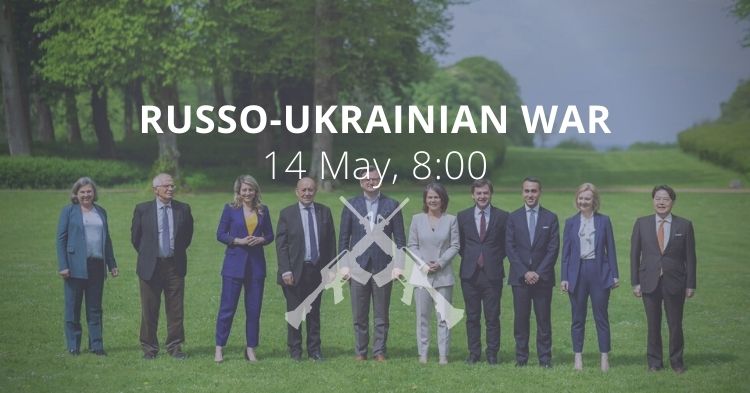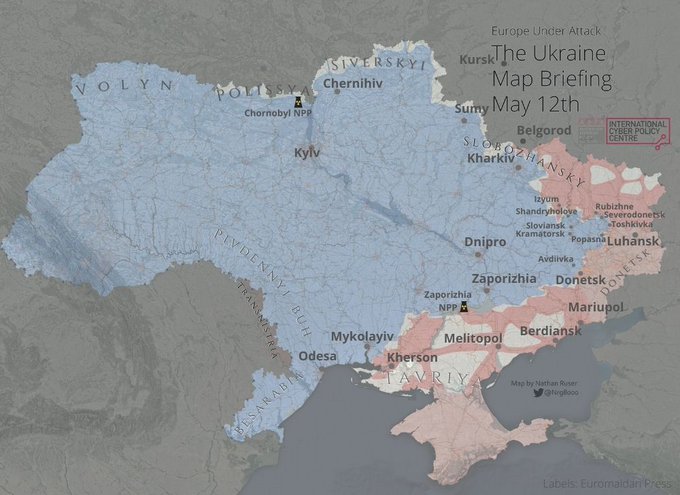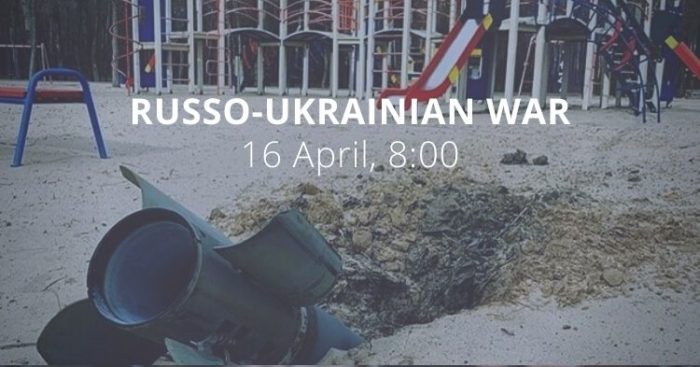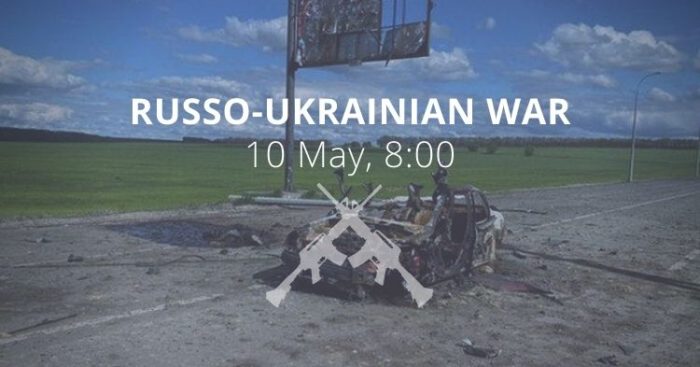Morning report day 80 – May 14
Situation
According to information from the General Staff as of 06.00 14.05.2022, supplemented by its [18:00 assessment].
Russian forces continue to fight in the Eastern Operational Zone, firing along the entire line of contact and in the depths of the defence of our troops. The greatest activity of Russian occupiers is observed in Slobozhansky and Donetsk directions.
There is still a threat that the enemy will launch missile and bomb strikes on military and civilian facilities in Ukraine.
In the Volyn and Polissya directions, Russian forces did not take active action. Up to seven battalions of the Armed Forces of the Republic of Belarus continue to carry out tasks to cover the Ukrainian-Belarusian border. The export of military equipment and property of the armed forces of the Russian Federation from the territory of the Republic of Belarus continues.
- [Its main efforts were to cover the state border in Brest and Gomel oblasts. As part of the inspection of the Armed Forces of the Republic of Belarus in the Kobrin district of Brest region and Lida district of Grodno region, meetings with conscripts continue.]
- [The threat of missile strikes from the territory of the Republic of Belarus on infrastructure facilities on the territory of Ukraine remains.]
In the Siversky direction, Russian forces provide enhanced protection of the Ukrainian-Russian border in the Bryansk and Kursk regions.
- [From the territory of the Russian Federation, the enemy fired artillery at civilian targets in the Sumy region and launched an airstrike on the village of Tovstodubovo.]
In the Slobozhansky direction, Russian forces did not conduct active hostilities in the Kharkiv direction. Its main efforts were focused on ensuring the withdrawal of his troops from the city of Kharkiv, maintaining the occupied positions and supply routes.
- [Russian forces’ main efforts are focused on ensuring the withdrawal of its units from the city of Kharkiv and preventing units of the [Ukrainian] Defense Forces from entering the rear of a Russian group of troops concentrated in the Izium area. Russian forces units fired on the positions of our troops in the areas of the settlements of Petrivka, Pytomnyk, Ruski Tyshky and Ternova.]
- In the Sloviansk direction, Russian forces carried out artillery shelling of civilian and military infrastructure in the areas of the settlements of Dovgenke, Dolyna and Husarivka. [Russian forces concentrated their main efforts on the offensive in the area of the settlement of Bohorodychne but had no success. Its conducted artillery shelling in the areas of Nova Dmytrivka and Krasnopillya. It carried out airstrikes in the areas of the settlements of Dolyna and Adamivka.]
- Russian occupiers conducted air reconnaissance using the Orlan-10 UAV in the areas of the settlements of Izium, Kapitolivka and Dibrova in the Kharkiv region.
In the Donetsk and Tavriya directions, Russian forces used mortars, artillery, rocket-propelled grenades, and aircraft to inflict maximum losses on units of the Defence Forces, deplete personnel and destroy fortifications.
- In addition, Russian forces are trying to improve the tactical situation in the areas of Komyshuvakha, Krasnohorivka, Novomykhailivka, Kostiantynivka and Pobeda. It is not successful.
- In the city of Mariupol, Russian forces continue to blockade our units near the Azovstal plant. Inflicts massive artillery and airstrikes.
- In the Zaporizhzhia direction, to maintain the occupied territory, there are preparatory measures for the construction of a multi-tiered defence by the occupiers.
- [The occupiers tried to establish control over the settlements of Novoselivka Druha, Kamyanka, Marinka and Novomykhailivka.]
- [In the Lyman direction, Russian forces tried unsuccessfully to gain a foothold in the area of the settlement of Oleksandrivka.]
- [In the Sievierodonetsk direction it carries out active influence fire in the area of the settlement of Rubizhne.]
- [In the Bakhmut direction, Russian forces carried out assault operations in the directions of the settlements of Zolotye and Komyshuvakha but were unsuccessful. Carries out shelling of the settlements of Toshkivka and Orikhove.]
- [In the Avdiivka direction, with the support of artillery, he is conducting offensive operations in the directions of the settlements of Kamyanka and Novoselivka and has no success.]
- Ten attacks by the Russian occupiers were repulsed in Donetsk and Luhansk over the past 24 hours, five tanks, five artillery systems, six units of armoured combat vehicles and seven enemy vehicles were destroyed.
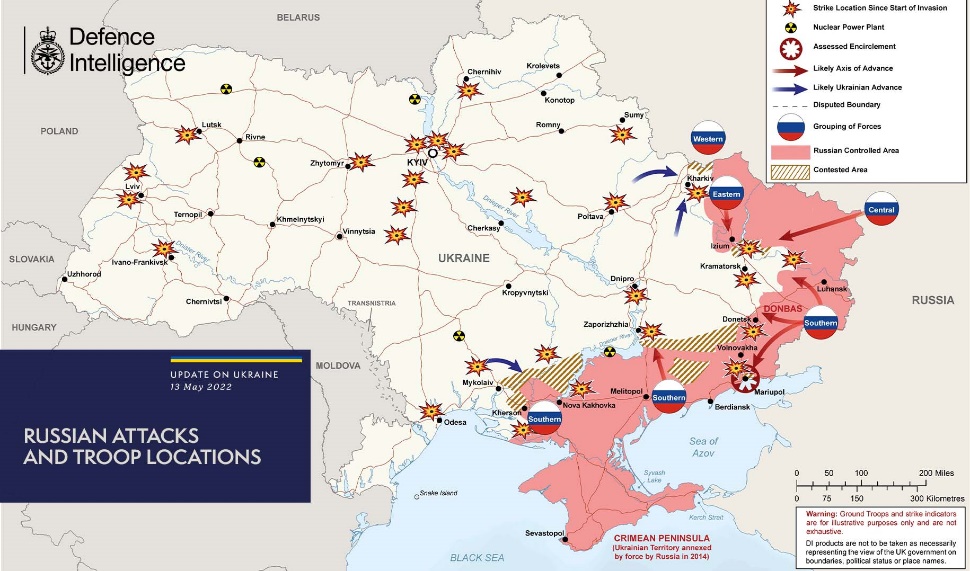
The situation in the Pivdenny Buh directions has not changed significantly. The enemy continues to shell the positions of our troops with mortars and artillery.
[Illegal actions against the local population continue in the territories temporarily occupied by the enemy. Measures of the administrative-police regime are underway, the counter-intelligence regime has been strengthened. Unreasonable detention of civilians, especially those with an active pro-Ukrainian position, continues.]
Air defence units shot down three Orlan-10 unmanned aerial vehicles.”
https://twitter.com/EuromaidanPress/status/1525325530760892417
Length of battle lines and Russian force composition is according to the Centre for Defence Strategies:
- Kharkiv direction: approx. length of the battle line is 100 km, the number of Russian BTG - 5, the average width of the BTG combat area is 20 km
- Izium direction: approx. length of the battle line is 60 km, the number of Russian BTG - 22, the average width of the BTG combat area is 2.7 km
- Sievierodonetsk direction: approx. length of the battle line is 100 km, the number of Russian BTG - 19, the average width of the BTG combat area is 5.3 km
- Popasna direction: approx. length of the battle line is 20 km, the number of Russian BTG - 7, the average width of the BTG combat area is 2.9 km
- Donetsk direction: approx. length of the battle line is 140 km, the number of Russian BTG - 20, the average width of the BTG combat area is 7 km
- Zaporizhzhia direction: approx. length of the battle line is 130 km, the number of Russian BTG - 14, the average width of the BTG combat area is 10 km
- Kherson direction: approx. length of the battle line is 160 km, the number of Russian BTG - 7, the average width of the BTG combat area is 22.8 km
Russians destroy the connection between Sievierodonetsk and Rubizhne, the Ukrainska Pravda reported Friday afternoon. "The destroyed bridge, which was the first in the Luhansk region to be rebuilt after the expulsion of the Russian invaders in 2014 – the transport connection between Sievierodonetsk and Rubizhne no longer exists. Hopefully, for a short period of time, the Head of Luhansk Oblast Military Administration, Serhii Haidai, wrote on Telegram
.
https://twitter.com/EuromaidanPress/status/1525375237113749508
In the Luhansk region, the Russian invaders hurl all effort into breaking through the line of defence, the Ukrinform reports, citing the Head of the Luhansk Regional Military Administration, Serhiy Haidai. “Our situation is getting more complicated because, as I understand it, the enemy hurls all effort into breaking through the line of defence at least somewhere. They assault Rubizhne, assault Hirske community from the side of Zolote and Nyzhnie, assault the outskirts of Sievierodonetsk.”
“Over the past day, more than 2,000 units of enemy equipment moved through Luhansk region and invaders delivered much personnel as well, Haidai noted. As noted, the enemy also tries to set pontoon crossings again to redeploy equipment and people across the Siversky Donets River near Bilohorivka. The invaders are constantly trying to erect a pontoon crossing at the same place, while the Armed Forces of Ukraine keep destroying it.”
Mutinous Russian soldiers are 'stripped, tied up and taken away in trucks by a feared general who's been sent in to restore discipline in Ukraine', The Daily Mail reports. Mutinous Russian soldiers were stripped, tied up and taken away in trucks under the orders of a feared Russian general who has been sent in to restore discipline in Ukraine, according to a recording released by Kyiv's intelligence services. The intercepted audio recording is the latest evidence that morale is deteriorating among Moscow's forces as its faltering invasion of Ukraine entered its 12th week.”
According to British Defence Intelligence, (last 24 hours):
- The Russian-imposed military-civilian administration in Kherson announced they will ask Russia to include Kherson Region in the Russian Federation. A central part of Russia’s original invasion plan was highly likely to use rigged referendums to place the majority of Ukraine’s regions under long-term pro-Russian authority.
- The fact that Russia has only succeeded in imposing a pro-Russian local leadership in Kherson highlights the failure of Russia’s invasion to make progress toward its political objectives in Ukraine.
- If Russia carries out an accession referendum in Kherson, it will almost certainly manipulate the results to show a clear majority in favour of leaving Ukraine. Citizens in the Kherson region are likely to continue to demonstrate their opposition to the Russian occupation.
As of Saturday 14 May, the approximate losses of weapons and military equipment of the Russian Armed Forces from the beginning of the war to the present day:
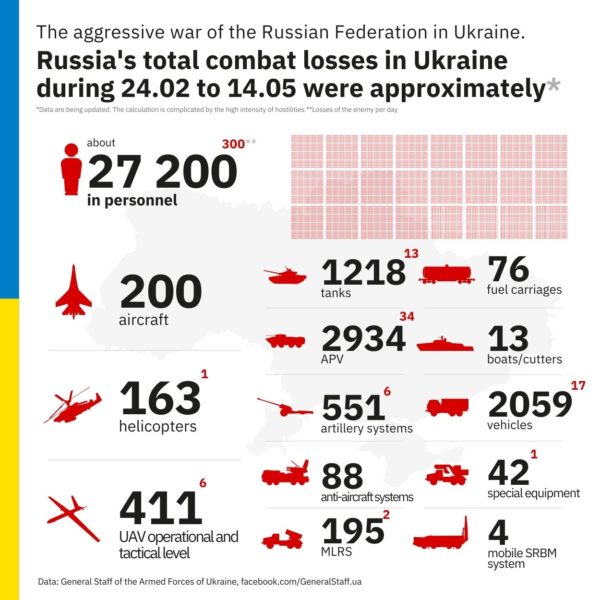
- Personnel – more than 27200 (+300),
- Tanks – 1218 (+13),
- Armoured combat vehicles – 2934 (+34),
- Artillery systems – 551 (+9),
- Multiple rocket launchers – 195 (+2),
- Air defence means – 88 (+0)
- Aircraft - 200 (+0),
- Helicopters - 163 (+1),
- Automotive technology and fuel tanks – 2059 (+17),
- Vessels/boats - 13 (+0),
- UAV operational and tactical level – 411 (+6),
- Special equipment – 42 (+1)
- Mobile SRBM system – 4 (+0)
- Cruise missiles –95 (+0)
Russian enemy suffered the greatest losses (of the last day) in the Kurakhiv direction.
Humanitarian
Azovstal defenders call on Western leaders to help with the evacuation of the wounded, the Ukrinform reports.
“The enemy is cynical; the enemy does not follow any international conventions. The enemy does not adhere to the Geneva Conventions. Knowing that about 600 wounded fighters are remaining within the Azovstal plant, they continue to drop bombs on a military hospital. This way, as usual, they violate all international regulations,” Azov Regiment Deputy Commander Captain Sviatoslav Palamar said. Palamar called on Western leaders to help with the evacuation of the wounded.
https://twitter.com/EuromaidanPress/status/1525104574297559041
Russian missiles hit Kremenchuk CHPP, again, the Ukrinform reports.
"There are no casualties, but the damage is significant. Reconstruction works have just begun at the CHPP but today came another strike. The Russian occupiers probably want 180,000 Kremenchuk residents dependent on this CHPP to be left without central heating in winter," Lunin said.
He noted that a total of 12 missile strikes were launched on Kremenchuk, with most of the missiles hitting a local refinery and one – the CHPP. The head of the administration stressed that these are high-precision missiles that hit exactly where they aim.
According to UNHCR 6,080,239 refugees have been registered as of May 12. The UN says that so far Poland has taken in 3,294,723 refugees, Romania 901,696, Russian Federation 800,104, Hungary 588,736, Republic of Moldova 460,782, Slovakia 412,345 and Belarus 27,308. Among those who fled Ukraine are also Ukrainian nationals with dual citizenship. An additional 105,000 people moved to the Russian Federation from the Donetsk and Luhansk regions between 18 and 23 February.
The number of Ukrainians entering Ukraine since February 28 is 1,662,500 as of May 12. This figure reflects cross-border movements, which can be pendular, and does not necessarily indicate sustainable returns.
OHCHR recorded 7,389 civilian casualties in Ukraine as of May 12. 3,573 were killed (including 241 children) and 3,816 injured (including 357 children).
Legal
Putin sends Mariupol survivors to remote corners of Russia as investigation reveals a network of 66 camps, I News reports.

An investigation by i analysing Russian local news reports has identified 66 camps in a network of former Soviet sanatoriums and other sites in regions including Siberia, the Caucasus, the Arctic Circle and the Far East. i‘s investigation marks the first evidence of a major operation to spread them across a country gripped by a historic post-Cold War population decline.
Tanya Lokshina, associate director for Europe and Central Asia at Human Rights Watch, told i: “There is ample evidence that thousands of Ukrainians were taken to Russia under duress. “When people are only given a choice to stay under increasingly heavy shelling or to enter the territory of an occupying power, it constitutes forced transfer under international humanitarian law.
“We are extremely concerned this is happening. People who seek evacuation to safer areas in Ukraine are shuttled off to Russia instead – in some cases to remote areas very far from Ukrainian or European borders. “They are vulnerable, destitute, often without identification documents and find themselves at the mercy of the occupying power.
While Ukrainians are able to walk out of the camps, their remoteness and a lack of money, phones or documentation mean those wanting to leave the country face an almost impossible task.”
https://twitter.com/EuromaidanPress/status/1525256057190227968
In the article “Why is Russia setting up detention centres in Ukraine?”
from 30 April, The Economist reports that “filtration camps”, a tool of terror used since the 1940s, have reappeared.
The concept of fil’tratsiia or filtration emerged at the end of the second world war, as the Soviet Union and other Allied forces liberated prisoners from the Nazis. […] Five decades later, filtration reappeared in Chechnya, a predominantly Muslim region in the northern Caucasus. During the two wars of the 1990s Russian authorities arbitrarily detained civilians at checkpoints, sending thousands to camps to stamp out Chechen separatism, adherents of which the Kremlin demonised as terrorists and bandits. Widespread human rights abuses including rape, extortion, beatings and torture were documented by human-rights groups. In many cases, detainees simply disappeared. There are disturbing parallels in Ukraine. Before Russia’s invasion, American officials said that Russian forces were creating lists of people to be killed or sent to camps if Russia occupied parts of the country. Likely targets included Russian and Belarusian dissidents in exile, anti-corruption activists, members of religious and ethnic minorities and LGBT people. […] [Escapees tell a story, comparing] conditions to those of a ghetto or concentration camp. They claim to have witnessed torture and killings carried out by Russian security services to weed out “Ukrainian Nazis”. According to the UN, the deportation or transfer of people from an occupied territory constitutes a war crime. Russia insists that the relocation of civilians by its armed forces is benign and voluntary. But filtration camps appear to be a tool of war, used to erase Ukrainian identity.”
Putin has forcibly deported 1.2 million Ukrainians to Russia and put them in 'filtration camps', The Daily Mail reports. Ukrainians are being taken against their will into Russia, the US has said, with some reports suggesting more than 1 million have been taken.
The deportation of Ukrainians from their own nation - often to isolated or economically depressed regions of Russia, according to Kyiv - is another indication that Putin simply won't accept and respect Ukrainian sovereignty. Ukraine's President Volodymyr Zelensky said back in early April, six weeks after Russia launched its deadly invasion, that thousands of Ukrainians had been sent to Russian territory. But that figure has since ballooned to more than 1.19 million, including at least 200,000 children, Ukraine's ombudswoman Lyudmyla Denisova said. Kirby stopped short of describing the deportations as ethnic cleansing, stressing it was not the Pentagon's place to make such determinations. But he said there was abundant evidence of 'Russian brutality' during the war. Moscow has had '75 days of brutalizing the nation of Ukraine and the Ukrainian people,' he said. 'And every time you think they just can't fall to a new low, they prove you wrong.”
Russia sends relatives of Ukrainian soldiers and other Mariupol residents to ‘concentration camp’ in occupied Donbas, the Kharkiv Human Rights Protection Group reports.
On 11 May, Andriushchenko announced that they had received answers to many questions regarding the Mariupol residents who had ‘not passed’ the filtration procedure and had disappeared. Those considered ‘unreliable’, he said, are sent to former corrective prison colony No. 52 in Olenivka (within ‘DNR’] or, possibly, to the Izolyatsia secret prison in Donetsk. No. 52 is where they place the relatives of military servicemen; former members of the law enforcement bodies; civic activists; journalists, as well as anybody deemed ‘suspicious’, for example, because of patriotic tattoos. The minimum term of incarceration is 36 days, with this the term allocated for so-called ‘filtration’. The premises are overcrowded, with facilities designed for 850 people holding at least three thousand, with most of these from Mariupol and the surrounding area. Those held there are not provided with sufficient water or food, and they are only taken to the toilet once a day. All of this is while they are subjected to interrogation lasting many hours; torture; threats of execution and attempts to force them to collaborate. Some are lucky and get released after 36 days, having been forced to sign whatever papers are thrust in front of them. Andriushchenko’s sources cannot say what the papers are but assume that these are about collaboration. He notes that there are a huge number of cases where people simply disappear after interrogation, with the gossip being that those ones have been sent to even worse prisons, including Izolyatsia. The latter is the most notorious of the secret prisons in occupied Donbas. Former inmates call this a concentration camp and have given harrowing accounts of the torture inflicted on both men and women. In fact, Andriushchenko is almost certainly right in saying that the so-called filtration camp at Olenivka can also be called a 21st century concentration camp.”
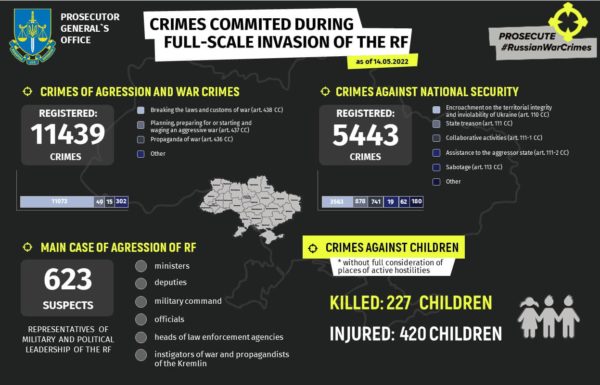 227 children were killed, and 420 children injured, the Office of the Prosecutor General of Ukraine reports as of May 14. 1,748 educational establishments are damaged as a result of shelling and bombings, 144 of them are destroyed fully. 11,439 crimes of aggression and war crimes and 5,443 crimes against national security were registered.
227 children were killed, and 420 children injured, the Office of the Prosecutor General of Ukraine reports as of May 14. 1,748 educational establishments are damaged as a result of shelling and bombings, 144 of them are destroyed fully. 11,439 crimes of aggression and war crimes and 5,443 crimes against national security were registered.
Support
Germany mulls supply of ten air defence systems to Ukraine – Bild, the Ukrinform reports.
“The German Security Council is discussing the supply of ten Diehl IRIS-T SLM air defence systems to Ukraine. This was reported by Bild citing sources in the German government. The range of IRIS-T SLM system is 40 km, while its operating altitude is 20 km. With the help of these air defence systems, the forces can repel the attacks of combat aircraft, helicopters, cruise missiles, and drones. If the supply is approved by the German Security Council, Ukraine may receive the first complexes in November 2022. It will take three to four years to produce all ten complexes requested by Ukraine. Ukrainian soldiers will have to undergo appropriate training in Germany.”
It will be hard for Ukraine’s economy to sustain a long war, and the Ukrainian government greatly relies on financial assistance from abroad. The relevant statement was made by Ukrainian Finance Minister Sergii Marchenko in an interview with The Economist.
“According to Marchenko, if the war lasts more than another ‘three or four months’, painful measures will be needed, involving huge tax rises and swingeing spending cuts. Marchenko noted that the real fear is that what had become in recent years a fairly market-driven, freewheeling economy might see a wave of nationalisations, undoing years of hard-fought progress.
According to Marchenko, he spends most of his day lobbying foreign governments for help. […] A reminder that Head of the Main Intelligence Directorate at the Ukrainian Defense Ministry Kyrylo Budanov expects the breaking point in the war to be in August and most active combat actions to finish by the end of the year.”
The European Union will provide a new tranche of EUR 500 million in military support to Ukraine, the Ukrinform reports. The relevant statement was made by EU High Representative Josep Borrell ahead of the G7 Foreign Affairs Ministers meeting in Weissenhaus, Germany.
“This is the seventh meeting of the G7 [Foreign Ministers] since the Ukrainian war started. And I am sure that we will come out with a strong message. The recipe is clear – more of the same. I mean, more support to Ukraine, including military support. I will announce that we, the European Union, we will provide a new tranche of 500 more million [EUR] to support the military of Ukraine. It will make about EUR 2 billion in total,” Borrell said. In his words, this EUR 500 million will be allocated for heavy arms, including armoured vehicles, tanks, heavy artillery, ammunition, and the things needed for the war. But, this sum is not enough to provide a lot of fighter jets.”
Ukraine is now the top recipient of US military aid, The Washington Post reports. The ramp-up in military spending, as well as a recent move to send more advanced equipment, indicates a recognition that the war may drag on, experts said.
“Previously we’d been providing aid packages every week or two to stave off defeat, said Mark Cancian, a senior adviser with the Center for Strategic and International Studies. But then the realization came that this thing could go on for quite a while. Cancian noted that the budget approved by the House goes through the end of the fiscal year, suggesting the expectation the war could last for at least four more months. Analysts see military aid from the West as vital to the success of Ukraine against a much larger adversary.
If the United States and other countries had not sent lethal aid from the very beginning, Ukraine would have been overwhelmed early on, and Ukraine’s government would now be a Russian puppet, Cancian said. Because militaries in combat need a continuous supply of munitions and equipment to replace losses, the United States and other countries needed to continue the flow of supplies. The aid is equal to more than half of the Ukrainian military budget last year.”
https://twitter.com/EuromaidanPress/status/1525134773454184448
Ukraine launches a platform #StandWithUkraine to draw world attention to the war in Ukraine. Together with partners, volunteers and top specialists from various fields, the Ministry of Culture has created and launched more than 20 large-scale projects to draw world attention to the war in Ukraine and consolidate the international community in the face of Russian aggression. Evidence of Russia's war crimes, destruction of cultural heritage, unique photos and videos, the fight against misinformation, military creativity and many other initiatives are now available on a single platform
New developments
- Macron suggested Ukraine give up some of its sovereignty to allow Putin to save face, says Zelensky, The New Voice of Ukraine reports. French President Emanuel Macron suggested Ukraine should compromise on its sovereignty to allow Russian dictator Vladimir Putin to save face, President Volodymyr Zelensky, said in an interview with Italian TV Station Rai 1 on May 13. According to Zelensky, Macron’s attempts to find an “off-ramp” for Russia are futile. Until Russia realizes it needs an out, it won’t be looking for reasonable ways to end the war. “It’s inappropriate for world leaders to suggest I should make certain sacrifices in terms of Ukraine’s sovereignty, in order to allow Putin to save face.”
- President Zelensky: Talks with Russia get complicated every day as new atrocities reveal, the Ukrinform reports. “In his words, the Ukrainian society had been ready to hold peace talks with Russia for over eight years since the war in eastern Ukraine started. But Russia’s full-scale invasion of Ukraine has changed public sentiments. Now the [Ukrainian] society is not positive about this, the President of Ukraine noted.”
- Putin and Scholz discuss 'blocked' Ukraine peace talks, Kremlin says, the Reuters reports. Russian President Vladimir Putin and German Chancellor Olaf Scholz discussed Ukraine in a telephone call on Friday, the Kremlin said. Putin told Scholz that progress in negotiations over an end to the conflict had been "essentially blocked by Kyiv", according to the Kremlin, which said contacts between Russia and Germany would continue on various levels. According to the TASS, Putin drew Scholz's attention "to the continuing gross violations of international humanitarian law by the Nazi ideology militants and the inhumane methods that they are using."
- Defense Secretary Lloyd Austin and his Russian counterpart held the first call since the invasion of Ukraine, the CBC News reports. “Defense Secretary Lloyd Austin spoke to his Russian counterpart, Defense Minister Sergei Shoigu, Friday for the first time since Russia initiated its invasion of Ukraine. According to a readout from the Pentagon, during the conversation with Shoigu, Austin "urged an immediate ceasefire in Ukraine and emphasized the importance of maintaining lines of communication." The call is the first time the two officials have spoken since Feb. 18.”
- The invasion is turning into a protracted war, but Russia has already suffered a strategic defeat, Ukraine's Defence Minister Oleksii Reznikov indicated in a Facebook post. Ukraine has forced Russia to reduce the scale of its targets to the operational and tactical level and is entering a long phase of the war. […] Thus, the strategic defeat of the Russian Federation on the battlefield was compounded by the strategic defeat at the international level. If we remember that the civilized world is tightening economic sanctions, and Finland and Sweden are preparing to apply for NATO membership, the international context for the Kremlin is systematically deteriorating. The world has a chance to defeat a dictatorship that poses a global threat. […] There is a strategic breakthrough in favour of Ukraine. This process will take some time. In the long run, these trends make the defeat of Russia inevitable," he wrote.
- Putin’s associate threatens crises, destruction, epidemics and wars due to sanctions against Russia, the Ukrainska Pravda reports, citing Medvedev on Telegram. “According to the forecasts of the Russian authorities, a major logistics crisis is possible in the post-anti-Russian sanctions’ world and the collapse of foreign airlines that are banned from flying over Russia. Medvedev said an energy crisis due to sanctions on Russian energy supplies, higher prices, and a full-fledged international food crisis with the prospect of starvation in some nations will ensue. The Russian Security Council expects a monetary and financial crisis, new regional military conflicts, and increased terrorist activity. He also writes about new epidemics due to "direct evidence of the use of biological weapons", as well as the decline in the activities of international institutions that have failed to influence the war in Ukraine, such as the Council of Europe.”
Assessment on the War
The Institute for the Study of War has made the following assessment as of Friday 13 May:
Ukraine thus appears to have won the Battle of Kharkiv. Ukrainian forces prevented Russian troops from encircling, let alone seizing Kharkiv, and then expelled them from around the city, as they did to Russian forces attempting to seize Kyiv. Ukrainian forces will likely attempt to disrupt at least the westernmost of the ground lines of communication (GLOCs) between Belgorod and Russian forces concentrated around Izium, although Russia is using several GLOCs, including some further away from current Ukrainian positions than any Ukrainian counteroffensive is likely to reach soon. The terrain east of current Ukrainian positions may also favor the Russians attempting to defend their GLOCs, as large water features canalize movement and create chokepoints that the Ukrainians would have to breakthrough.
Russian troops continued efforts to advance all along the periphery of the Izium-Donetsk city salient but made little progress. Russian forces attempted a ground offensive from Izium that made no progress. We had previously hypothesized that Russia might give up on attempts to advance from Izium, but the Russians have either not made such a decision or have not fully committed to it yet. Small-scale and unsuccessful attacks on the southern end of the salient near Donetsk City continued but made no real progress.
The main Russian effort continues to be the attempt to encircle Sievierodonetsk and Lysychansk from the north and from the south. Russian troops attacking from Popasna to the north made no significant progress in the last 24 hours. Russian forces coming north-to-south have failed to cross the Siverskyi Donets River and taken devastating losses in their attempts. The Russians may not have enough additional fresh combat power to offset those losses and continue the offensive on a large enough scale to complete the encirclement, although they will likely continue to try to do so.
The Ukrainian defenders of Mariupol continue to fight despite the odds, although Russian attackers appear to have penetrated into the Azovstal facility.
Key Takeaways
- Ukraine has likely won the Battle of Kharkiv. Russian forces continued to withdraw from the northern settlements around Kharkiv City. Ukrainian forces will likely attempt to disrupt Russian ground lines of communication to Izium.
- Ukrainian forces have likely disrupted the Russian attempt to cross the Siverskyi Donets River in force, undermining Russian efforts to mass troops in northern Donbas and complete the encirclement of Sievierodonetsk and Lysychansk.
- Russian forces have likely secured the highway near the western entrance to the Azovstal Steel Plant but fighting for the facility continues.
- Russian forces in Zaporizhzhia Oblast are likely attempting to reach artillery range outside Zaporizhzhia City.
- Ukrainian forces are reportedly attempting to regain control of Zmiinyi (Snake) Island off the Romanian coast or at least disrupt Russia’s ability to use it.“
The Russian annexation of occupied Ukraine is Putin’s unacceptable “off-ramp”, the ISW argues.
Putin’s timeline for annexation is likely contingent on the extent to which he understands the degraded state of the Russian military in Ukraine. The Russian military has not yet achieved Putin’s stated territorial objectives of securing all of Donetsk and Luhansk oblasts and is unlikely to do so. If Putin understands his military weakness, he will likely rush annexation and introduce the nuclear deterrent quickly in an attempt to retain control of the Ukrainian territory that Russia currently occupies. If Putin believes that Russian forces are capable of additional advances, he will likely delay the annexation in hopes of covering more territory with it. In that case, his poor leadership and Ukrainian counteroffensives could drive the Russian military toward a state of collapse. Putin could also attempt to maintain Russian attacks while mobilizing additional forces. He might delay announcing annexation for far longer in this case, waiting until reinforcements could arrive to gain more territory to annex. Ukraine and its Western partners likely have a narrow window of opportunity to support a Ukrainian counteroffensive into occupied Ukrainian territory before the Kremlin annexes that territory. Ukraine and the West must also develop a coherent plan for responding to any annexation and to the threat of nuclear attack that might follow it. The political and ethical consequences of a longstanding Russian occupation of southeastern Ukraine would be devastating to the long-term viability of the Ukrainian state. Vital Ukrainian and Western national interests require urgent Western support for an immediate Ukrainian counteroffensive.
Consequences and what to do?
Hans Midttun's assesment: Europe must learn from its past mistakes and make sure no side is humiliated when Russia and Ukraine negotiate for peace, France's President Macron said on 9 May. His hint for an off-ramp was echoed by President Joe Biden, who said he was worried that Russian President Vladimir Putin "doesn't have a way out right now, and I'm trying to figure out what we do about that."
French President Emanuel Macron's suggestion that Ukraine should compromise on its sovereignty to allow President Putin to save face, is a continuation of previous statements. More importantly, it is a continuation of the 8-year German and French diplomatic effort to push the Minsk Agreement at the cost of Ukrainian independence and sovereignty.
Europe must learn from its past mistakes and make sure that it never again supports a peace plan with no prospect for peace and a peaceful resolution of the war. The international community cannot be seen to be fronting a “Minsk Agreement version 3.0” as we recognise that 8 years of diplomacy failed to stop a full-scale invasion that was 8 years in preparation.
After 8 years in Ukraine, I want to be abundantly clear on a huge misconception: While the international community under German and French leadership might force the Ukrainian Government to accept a compromise, and accept the loss of territory, the Ukrainian population will never accept peace at these terms. A compromise – or off-ramp – at these terms can never bring peace to Europe.
Defeat and withdrawal are the only acceptable way out of the conflict. 15 years of concessions to Russian aggressions have resulted – and will result - in more war.
The ISW believes that President Putin most likely will annex occupied southern and eastern Ukraine. This will allow him to “state, directly or obliquely, that Russian doctrine permitting the use of nuclear weapons to defend Russian territory applies to those newly annexed territories. Such actions would threaten Ukraine and its partners with nuclear attack if Ukrainian counteroffensives to liberate Russian-occupied territory continue”.
The deliberations of both President Biden and President Macron are most likely connected to the Russian “fait accompli strategy” and its increasing threats of WW3 and the use of nuclear arms.
The Russian invasion of Ukraine was partly justified by the false narrative of an imminent threat from the USA and NATO. After nearly 3 months of fighting and a “strategic defeat of the Russian Federation on the battlefield deepened by a strategic defeat at the international level”, the “wall” dividing Russia from the West is back. Having been undressed in Ukraine and lost its conventional military deterrence, nuclear deterrence will have an even more important role in the future.
The present NATO strategy is based on the ethical dilemma of risking mutual destruction over Ukraine. If NATO decides to give in to the threats, however, the risk of further Russian aggressions even into NATO's area of responsibility will increase. The dilemma does not change because it is a NATO Article 5 scenario. Either you believe the threat is real and give in, or you call the bluff and challenge the military situation on the ground.
The only certainty amid our common security concerns is that Russia will take on step forward every time NATO take a step back. Russia will not abandon a strategy of war and intimidation if that helps it achieve its strategic aim and objectives.
If Russia is allowed to keep Luhansk, Donetsk, Zaporizhzhia, Kherson and the Crimean Peninsula, Ukraine has already lost its sovereignty and independence. If that happens, while Russia might have lost most battles, it has still won the war. That comes also at the cost of European stability, prosperity, and security.
Seeking a diplomatic solution to a conflict Russia insists on solving by military means, is after more than 8 years of failure, exactly what Einstein meant when he (allegedly) said that “Insanity Is Doing the Same Thing Over and Over Again and Expecting Different Results”.

